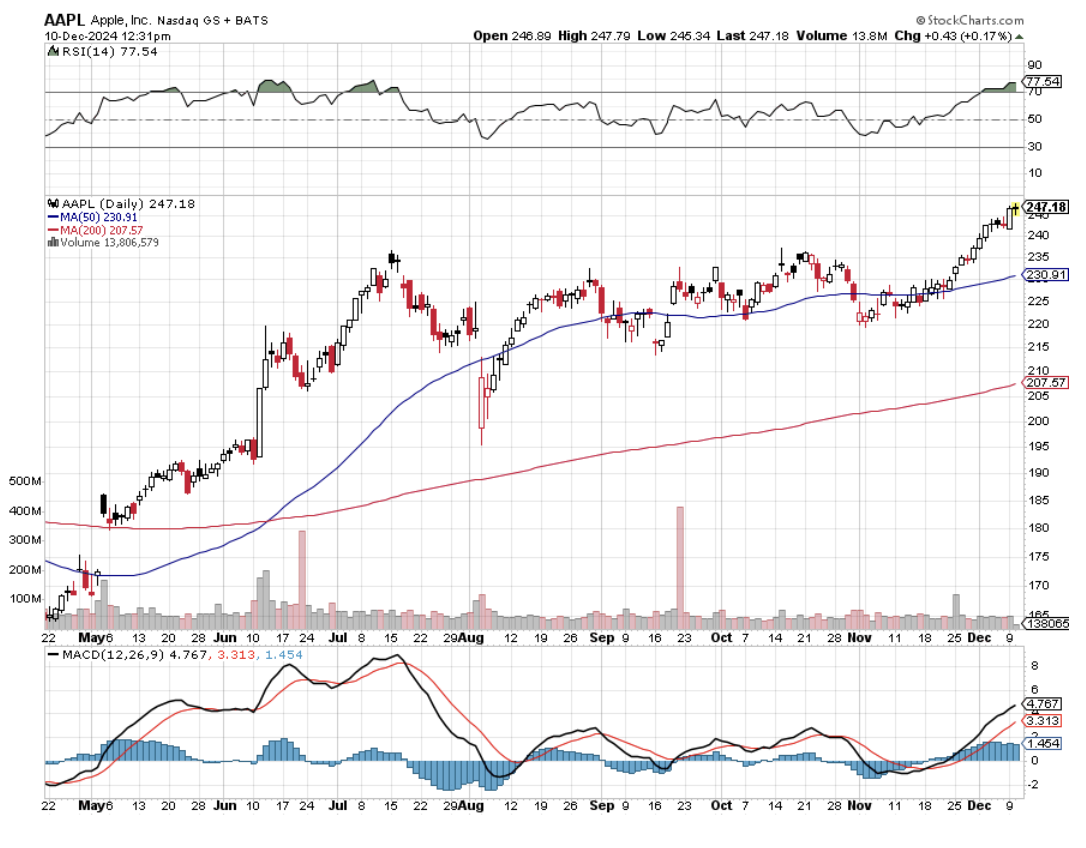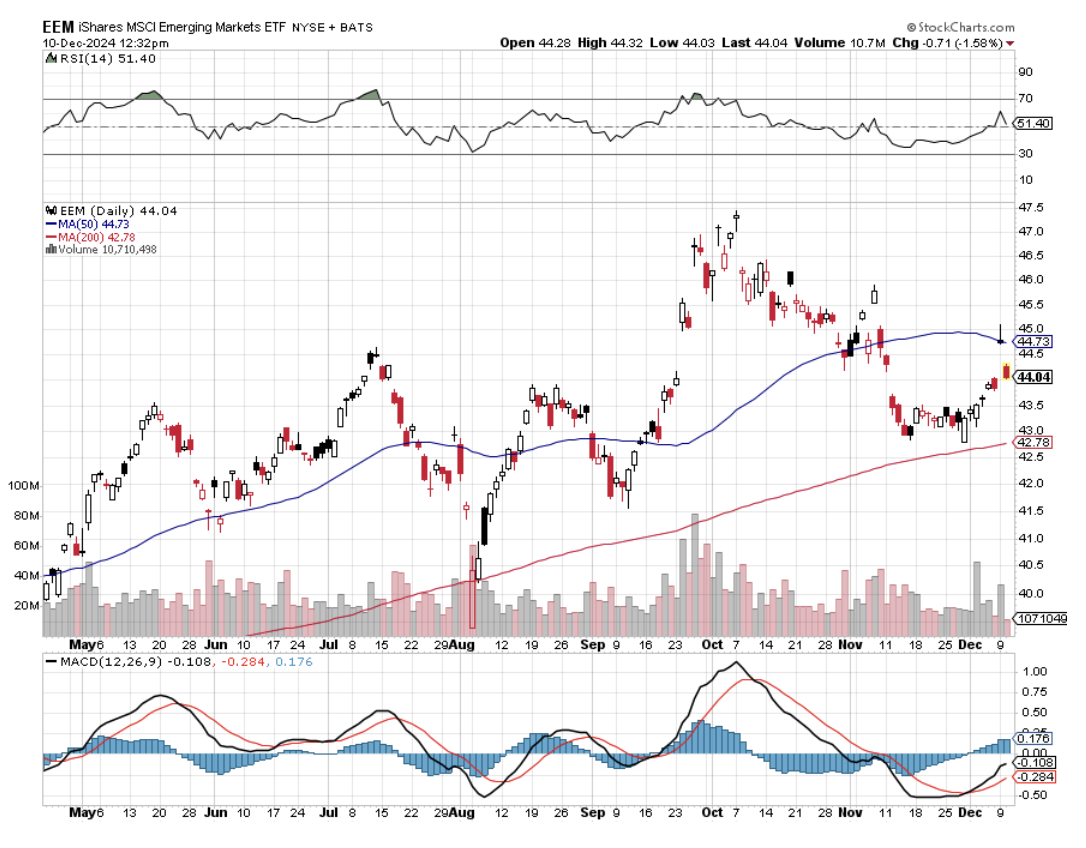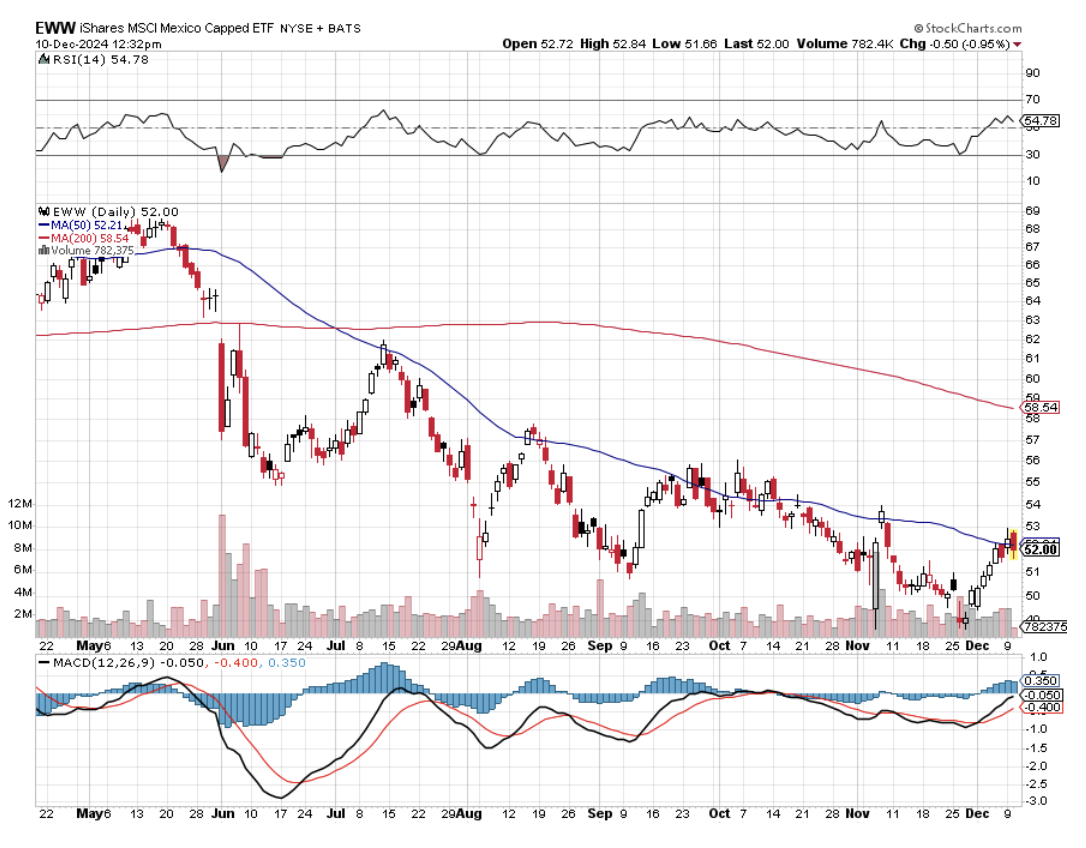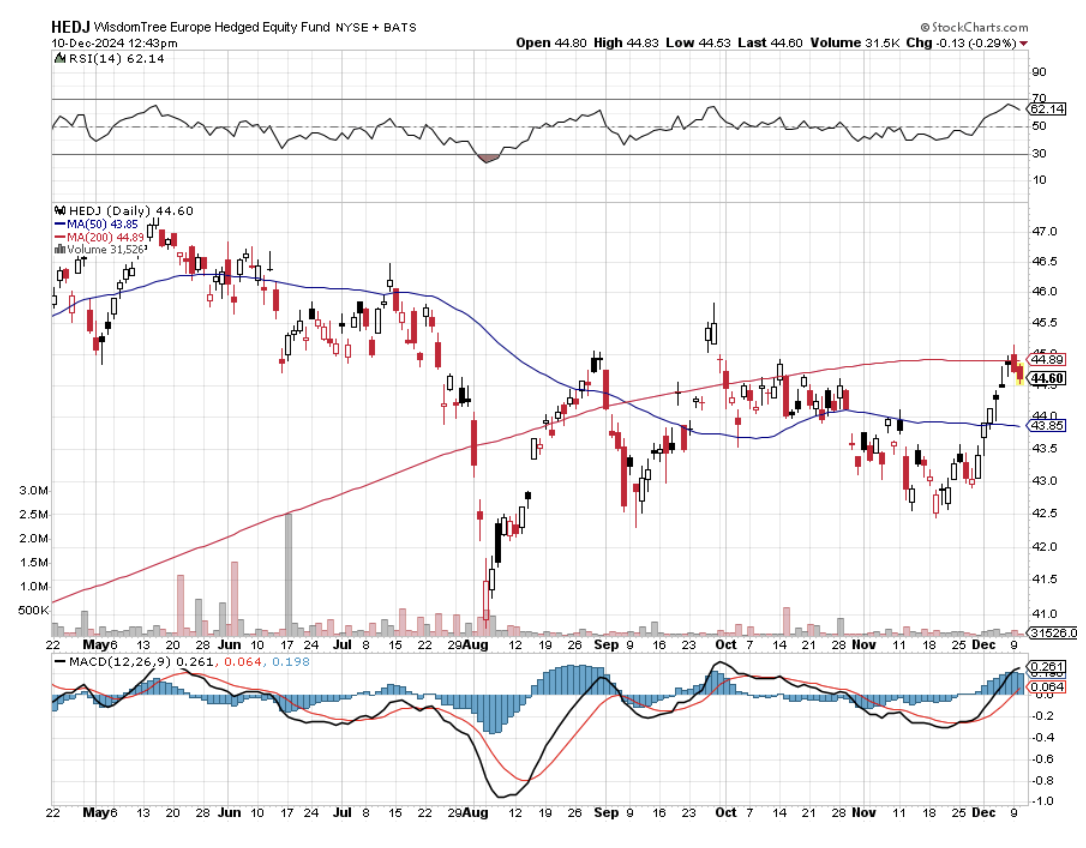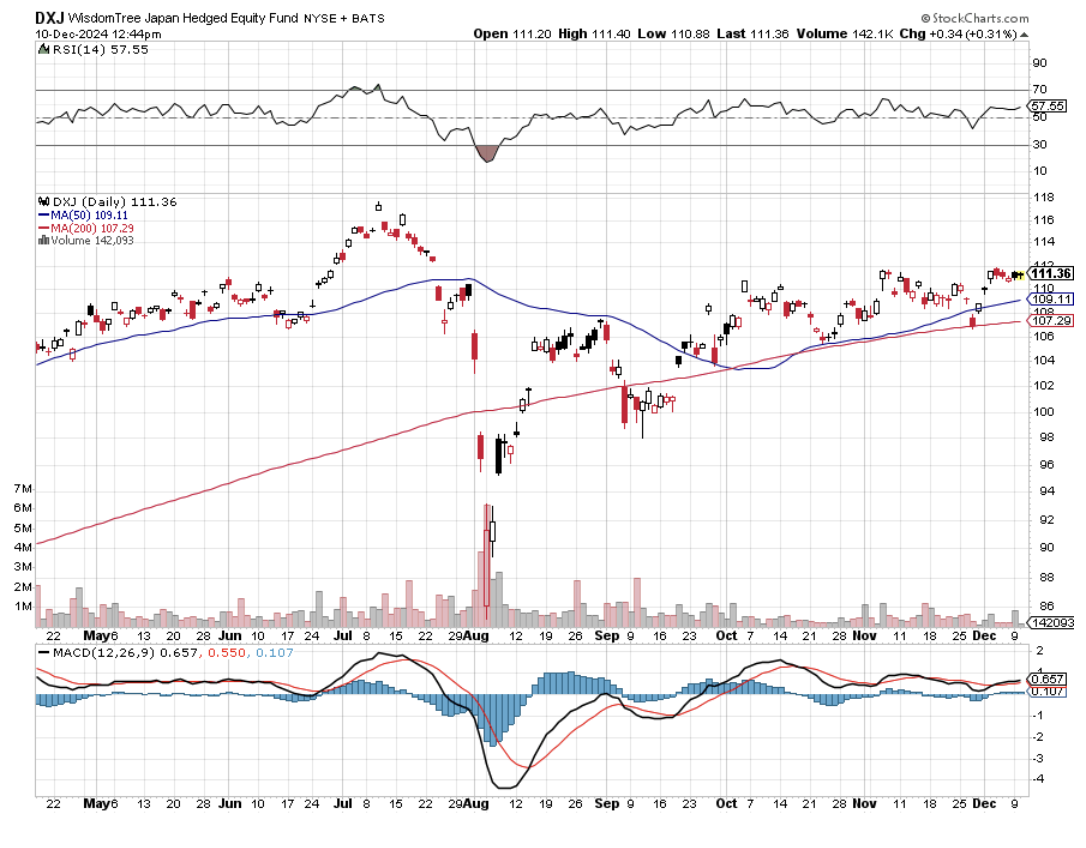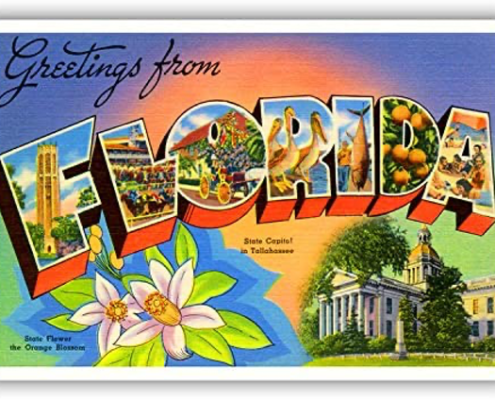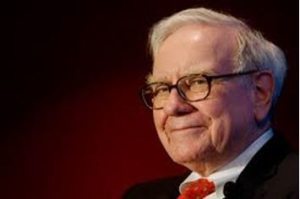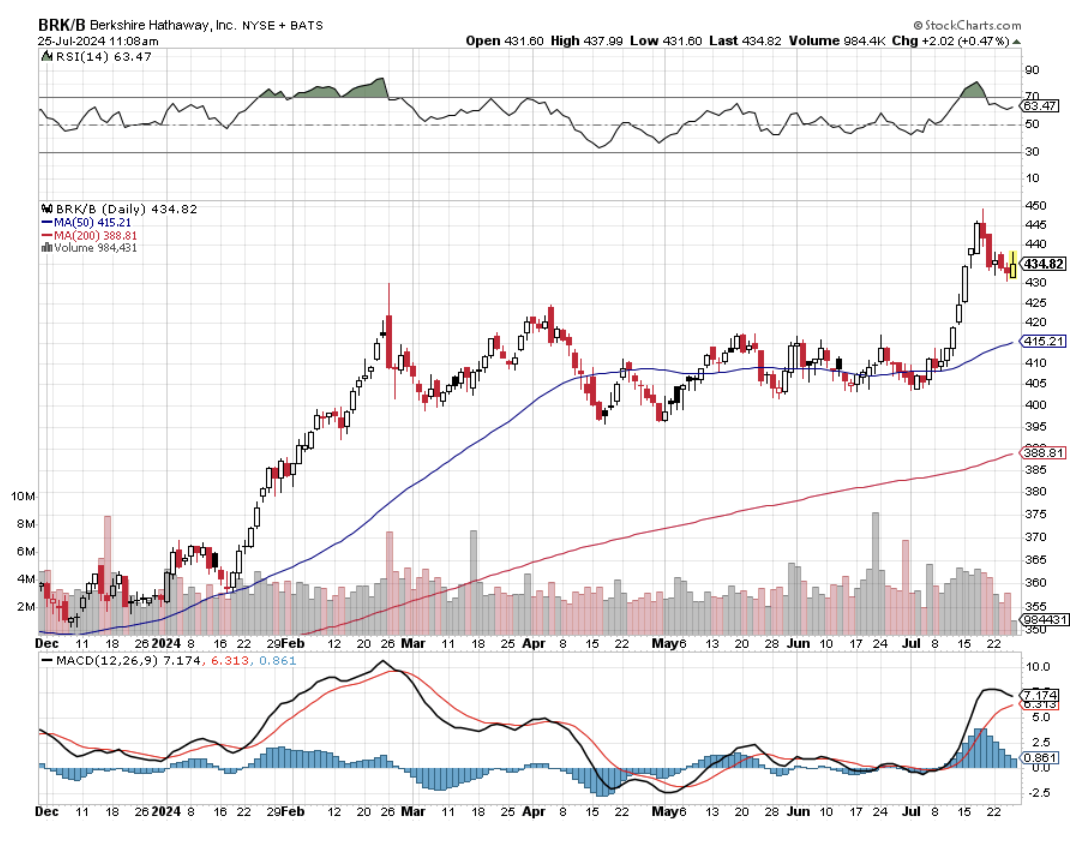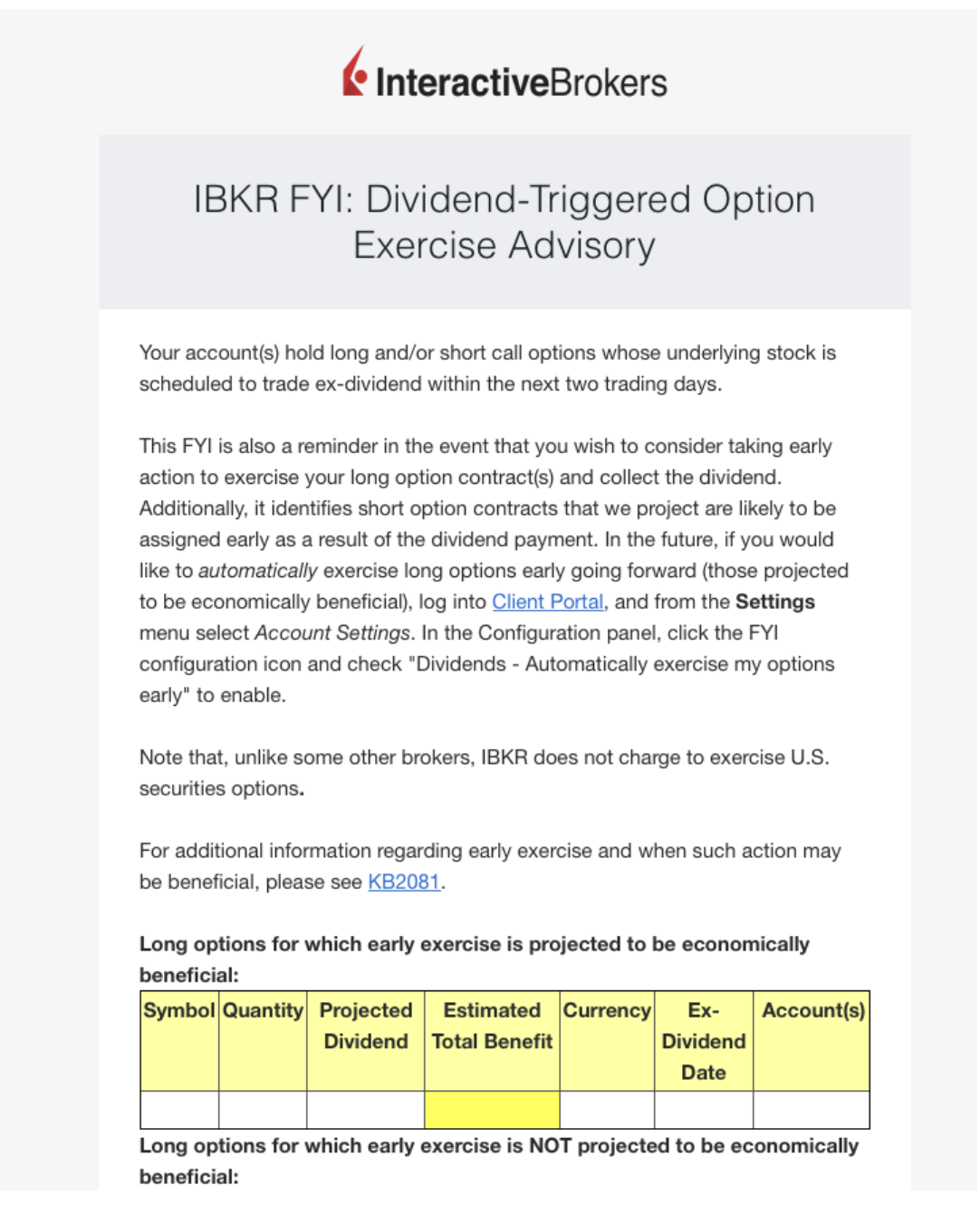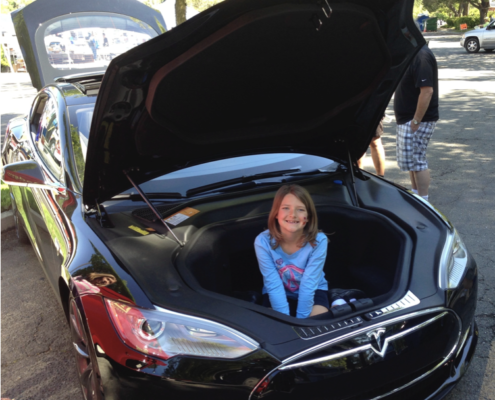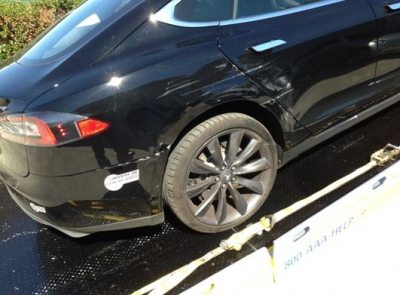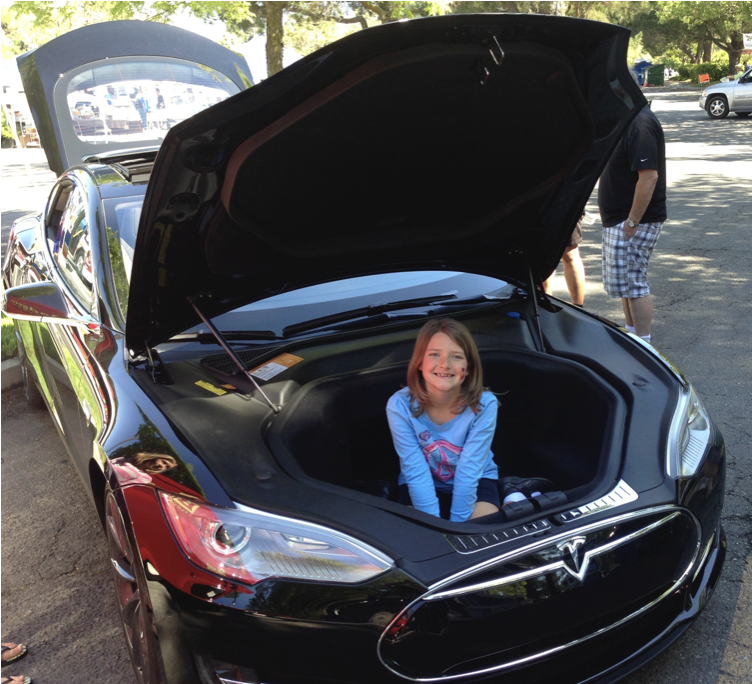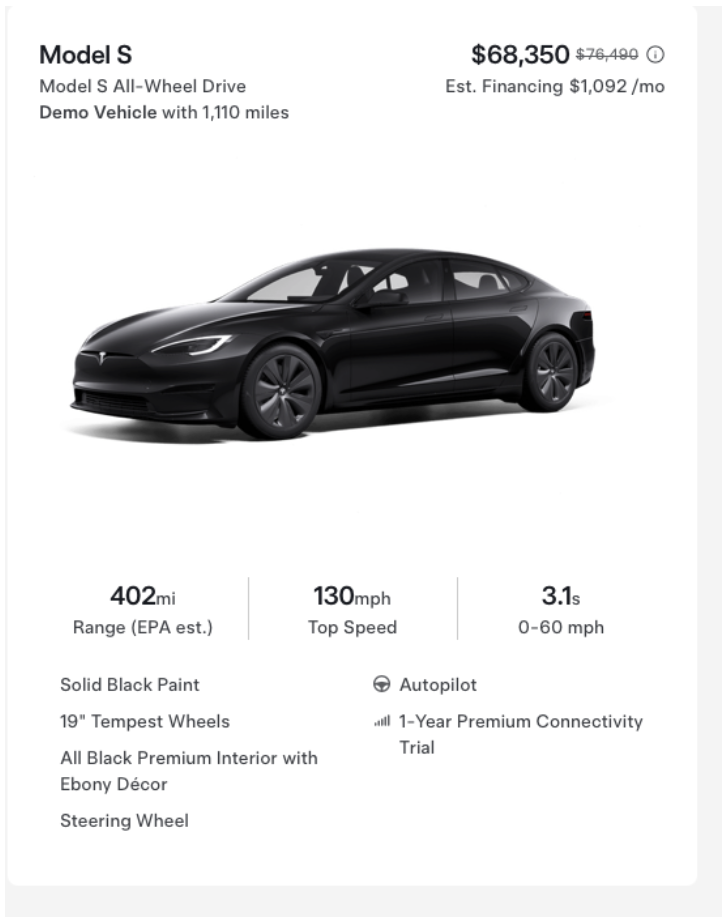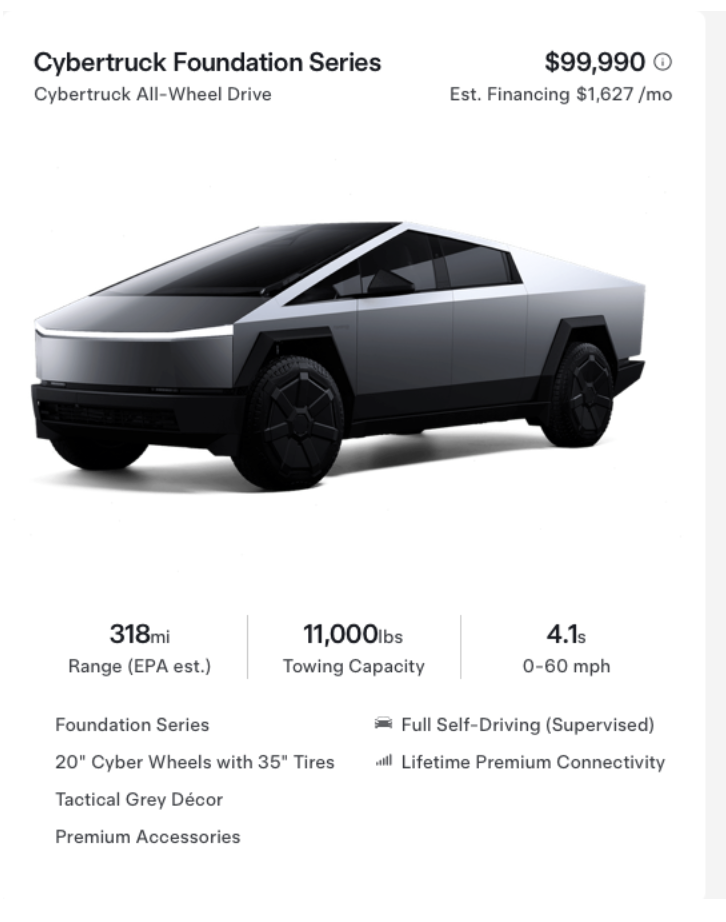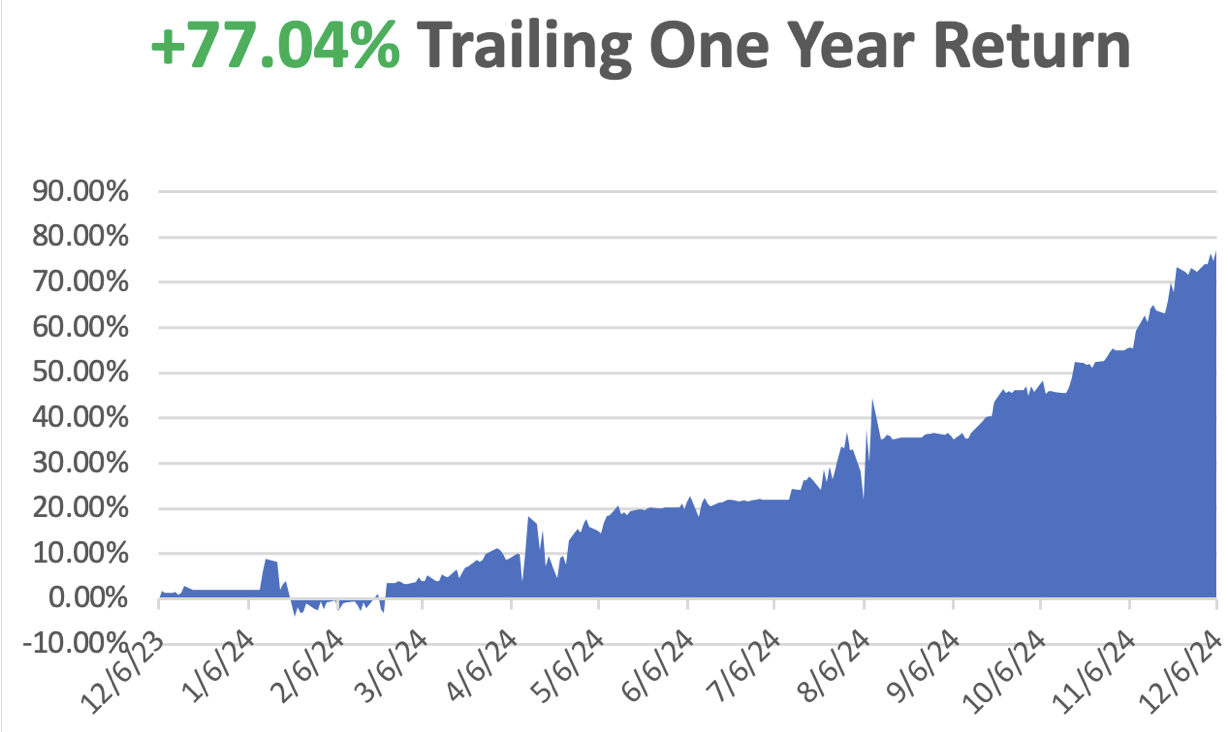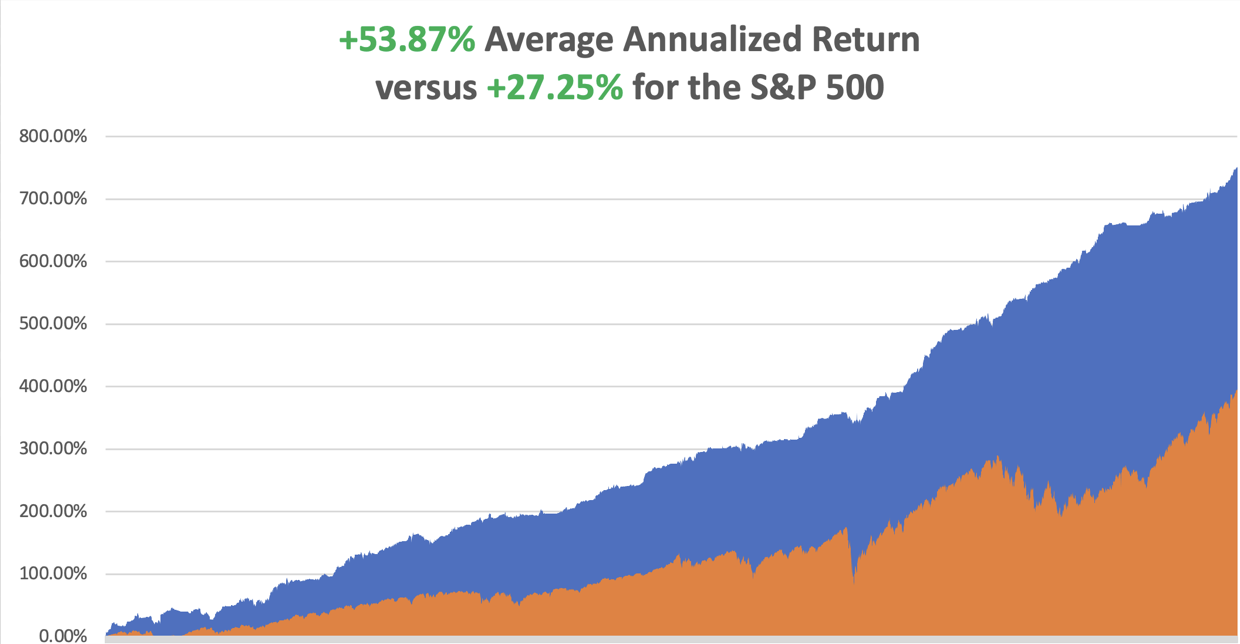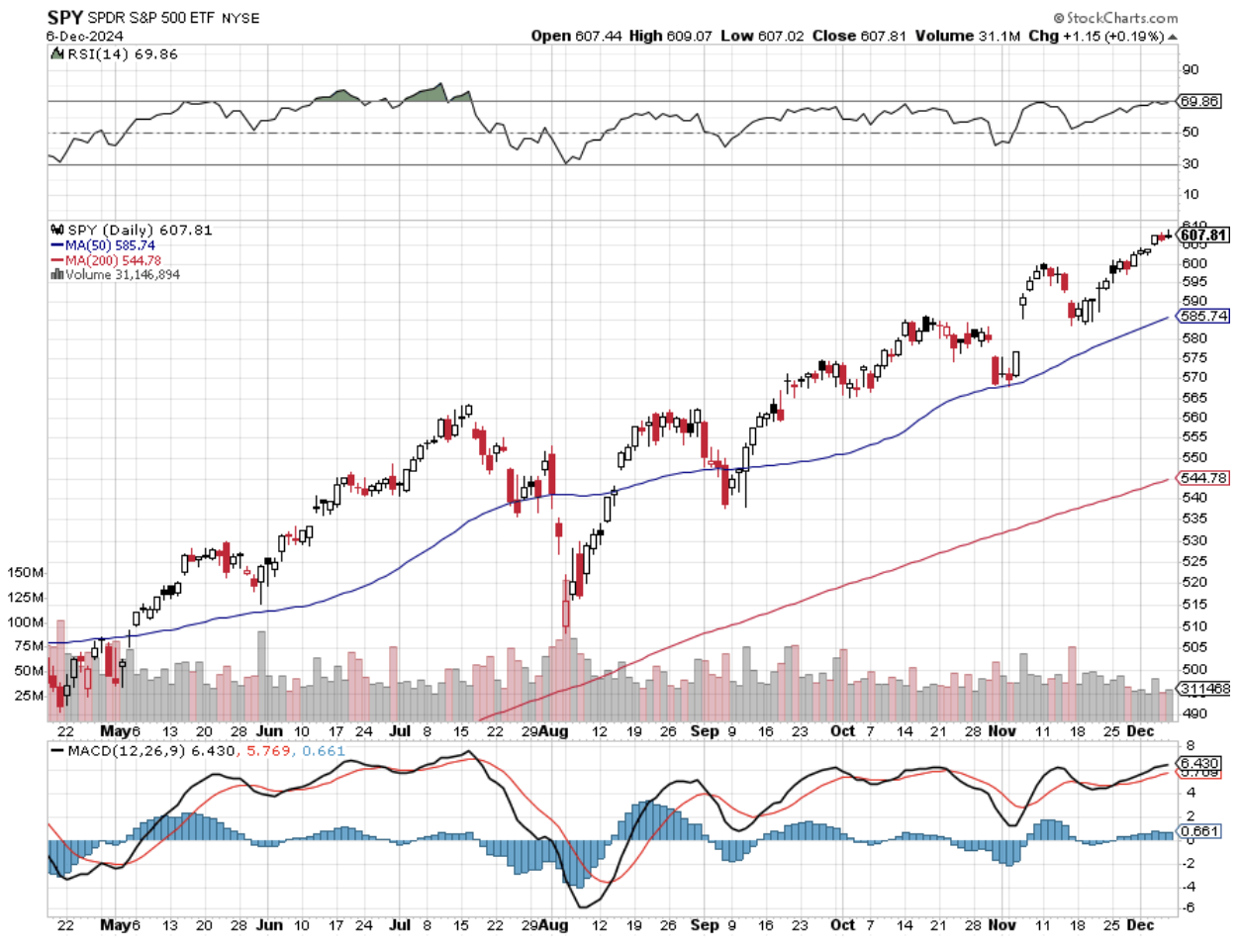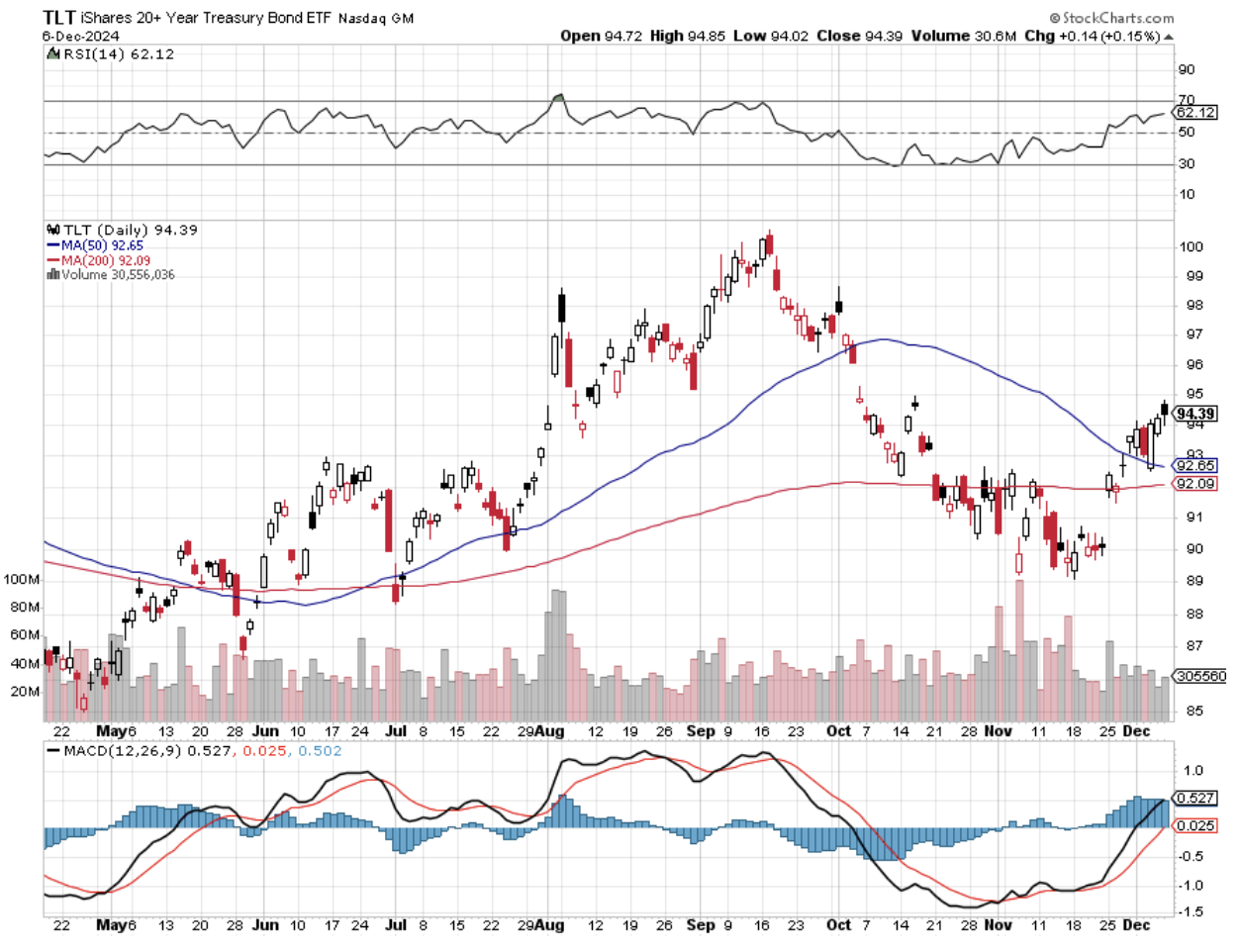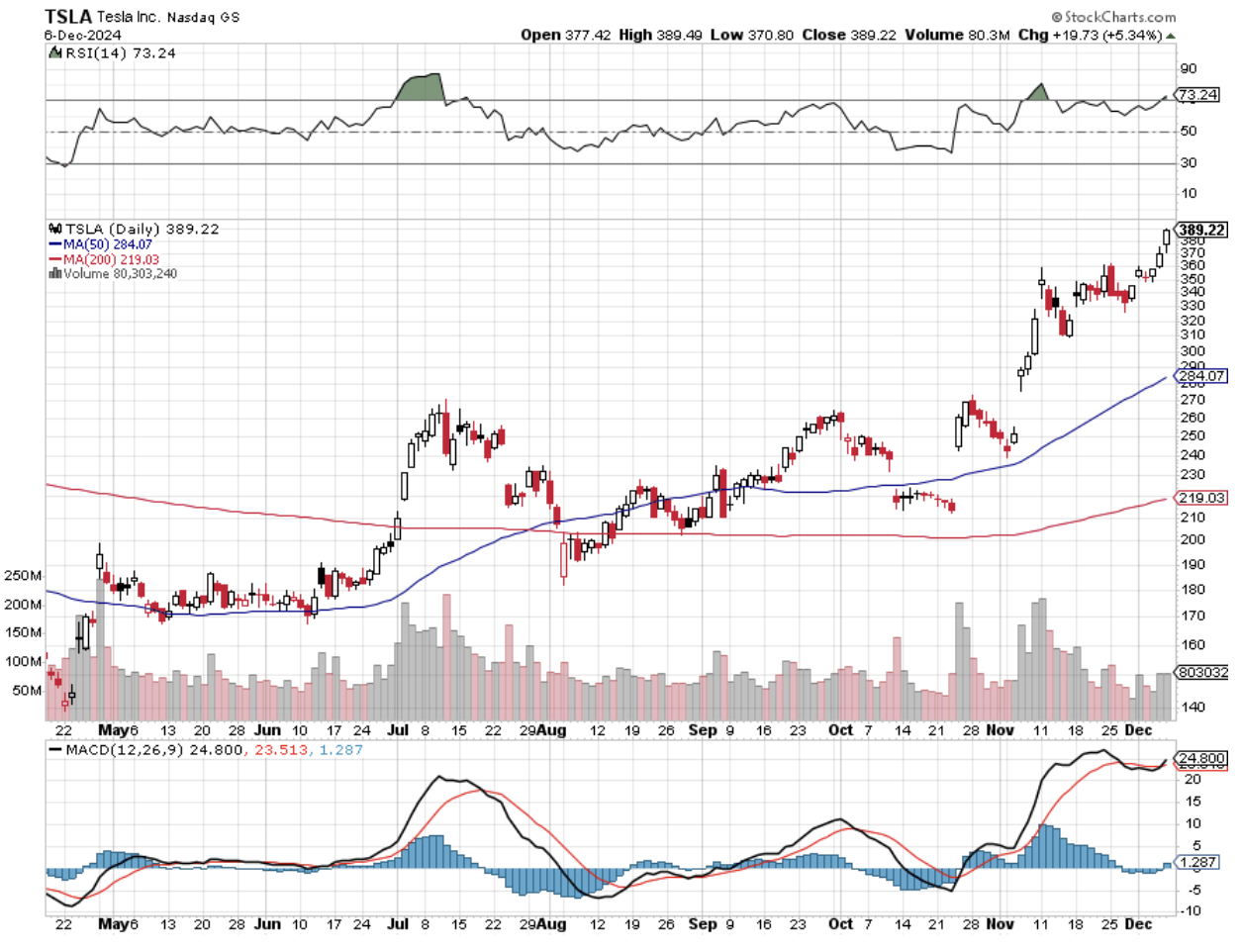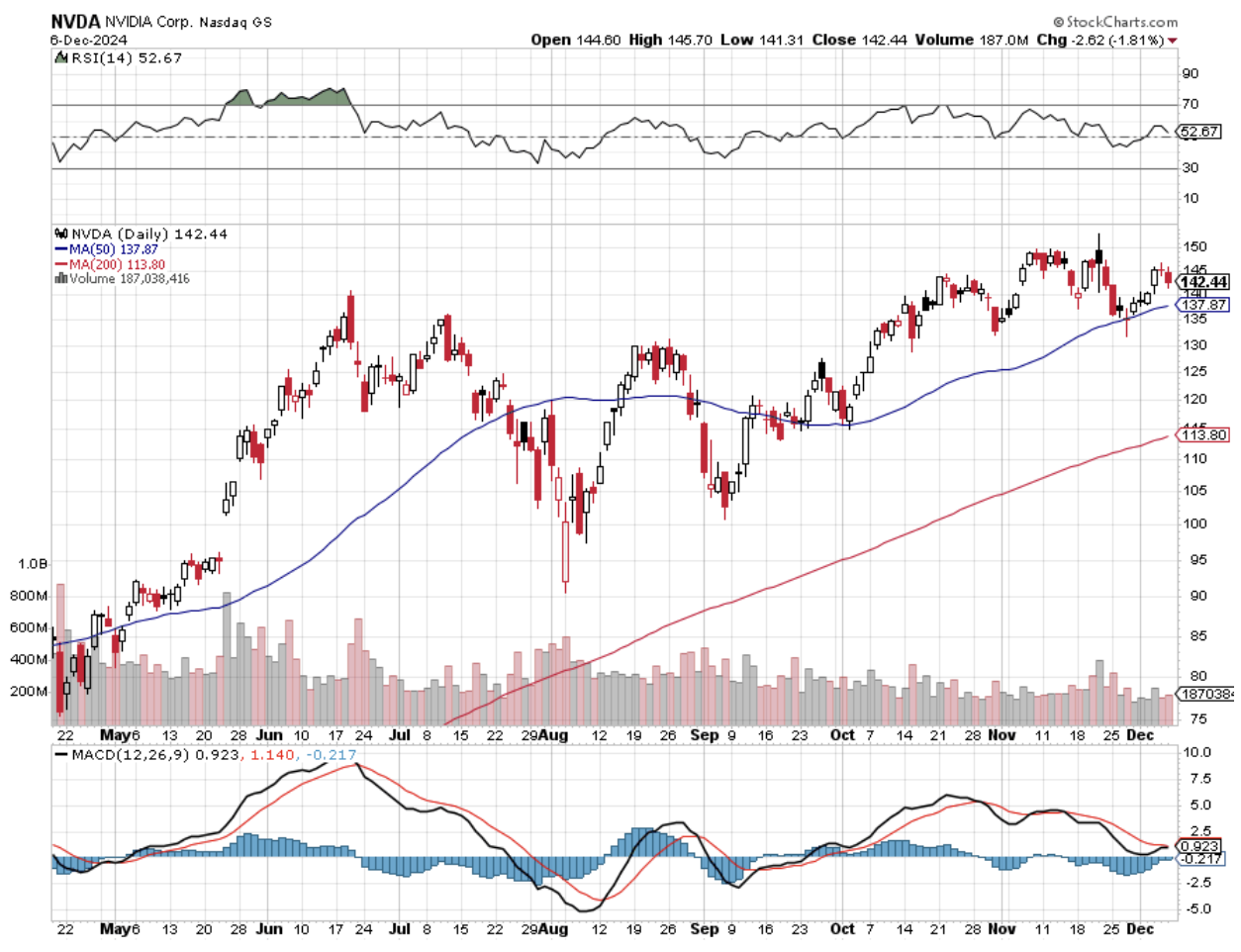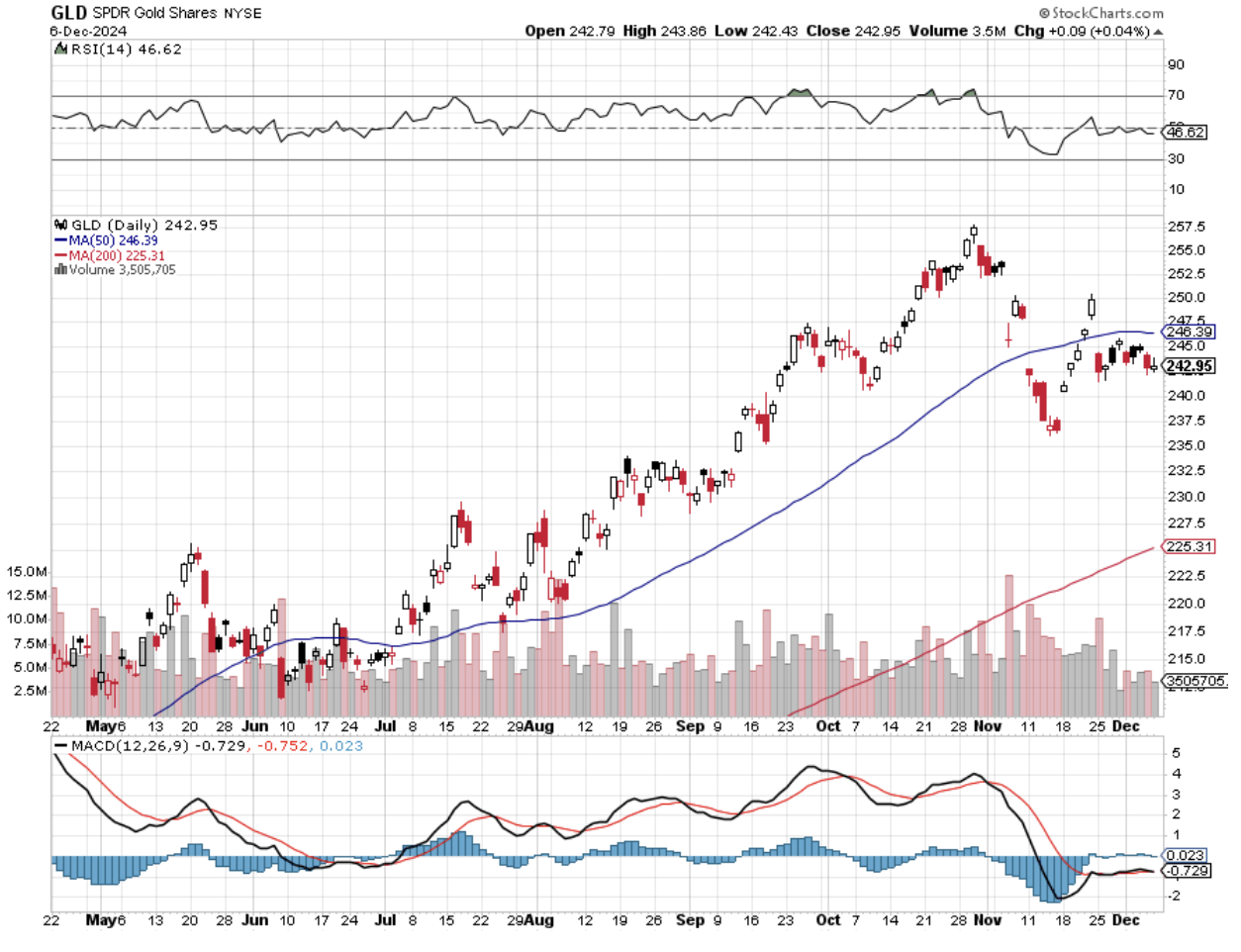
I am a firm believer in the wisdom of crowds.
This means that markets made of millions of participants can see things well before any individual human can.
The consequences for your portfolio can be earthshaking.
So, while the president campaigned on promises that he would immediately impose a 25% import duty on Canada and Mexico, here we are, some 38 days post-election, and many stocks that would suffer from a trade war are doing nothing.
In other words, there ain’t going to be no stinking trade war.
Markets came to this conclusion months ago. You could see this in a whole host of different and disparate asset classes.
Technology is the big one.
The biggest victim of any trade war would be technology firms, which operate the most globalized business models on the planet.
They design products here in the US and use slave labor in China to assemble them for pennies on the dollar, free of wage, OSHA, environmental, health, and child labor concerns.
They then sell them in the US and around the world for enormous profits.
In a world careening off the globalization cliff, you would expect Apple (AAPL) shares to get a pasting.
Yet, the jewel of Silicon Valley has seen its shares rocket by 38.46% since the November 5 election and an eye-popping 12.27%.
Remember, at $3.73 trillion, this is the largest public company in the world doing this! While no one was watching, (AAPL) approached an incredible $4 trillion market cap.
No trade war here!
Look elsewhere across the investment universe, and you see the same thing happening everywhere.
Emerging markets (EEM), whose economies are highly dependent on a functioning global trade system, have been unchanged since November 5.
And what has been the best-performing emerging nation?
Mexico (EWW), which has usurped about one-third of the US car industry. The (EWW) is up slightly since the election.
Guess what?
Not only is there not going to be a stinking trade war, but there isn’t going to be a stinking wall with Mexico either, just a token, Erector Set, pretend one. A budget-balancing Congress won’t pay for it.
China ($SSEC) is posting respectable gains, up 6.3%. What’s more, stock markets in Japan (DXJ) and Europe (HEDJ) have been edging out gains.
So, where did the trade war go?
I’ll list seven of the most obvious reasons.
1) The US has been a massive beneficiary of the globalized trade system. It has allowed America to remain the world’s most dominant and successful economy since WWII.
It has also preserved the US dollar as the world’s preeminent reserve currency, an enormous free lunch for US citizens.
2) American companies have been globalizing for 80 years, making them the most efficient and profitable on the planet.
Many trillions of dollars have been poured into foreign manufacturing and distribution systems. It all runs like a fine-tuned Swiss watch.
It cannot be undone or turned off by the slash of a pen on an executive order. Companies are better off paying lip service to the White House, which they have been doing on a daily basis, and then carrying on as they always have been.
4) To retreat from globalized business models would reduce the profitability of US corporations and send share prices plummeting. There’s no way you increase labor costs from $8 an hour to $80 and then increase your dividend.
5) A retreat would also hand over the international trading system to the Chinese, not exactly a development in America’s self-interest.
6) Some of the most ardent globalizationists I know are the generals and admirals of the US military.
7) Not only are Americans making fortunes off of globalization, so are foreigners. Wealthy customers are the best ones to have. If they are getting rich off you, they tend not to bomb you.
When notified that the State Department budget was going to get cut by 30%, former Defense Secretary James Mattis, a friend, replied, “Then I’m going to need a lot more bullets.”
Bottom line: It’s cheaper to talk to people than to kill them.
Those who were around during the early days of the globalization, like myself, remember that it was originally conceived as a national defense strategy.
By trading with a potential adversary, you create an embedded core of local businessmen who don’t want any political stability or wars to interrupt their profit stream. When Putin came back into power, the first thing he did was remove Russia from the global trading system.
Since there isn’t going to be a trade war, the investment implications are obvious.
You want to use every dip to load the boat on every globalization stock out there, especially in technology.
How do You Spell “Made in USA?”
“People are investing with a rear-view mirror. Last year, you had people scared out of the market. Unfortunately, you are losing a generation of investors at a time when they ought to be thinking about buying high quality stocks,” said Hersh Cohen of Clearbridge Advisors.
Global Market Comments
December 11, 2024
Fiat Lux
Featured Trade:
(JANUARY 10 MIAMI FLORIDA STRATEGY LUNCHEON)
(THE BEST TESTIMONIAL EVER)
Come join me for lunch for the Mad Hedge Fund Trader’s Global Strategy Update, which I will be conducting in Miami, Florida at 12:00 PM on Friday, January 10, 2025. A three-course lunch is included.
I’ll be giving you my up-to-date view on stocks, bonds, currencies commodities, precious metals, and real estate.
And to keep you in suspense, I’ll be throwing a few surprises out there too. Enough charts, tables, graphs, and statistics will be thrown at you to keep your ears ringing for a week. Tickets are available for $267.
I’ll be arriving early and leaving late in case anyone wants to have a one-on-one discussion or just sit around and chew the fat about the financial markets.
The lunch will be held at an exclusive hotel in the Coconut Grove sector of Miami, the details of which will be emailed to you with your purchase confirmation.
I look forward to meeting you, and thank you for supporting my research.
To purchase tickets for this luncheon, please click here.
I was pondering a TESLA trade alert from MHFT today when my cell rang with a Lake Tahoe area code. Since I know a couple of people in that part of the world, I answered, and it was none other than John Thomas.
If I had not heard his voice on the MHFT webinars, I would have thought I was being conned. But given that I’m in the last month of a trial run, he actually called to find out how I was doing with the service and what I thought.
Here’s the short version of what I told him.
I’m a pretty experienced investor, but definitely not sophisticated when it comes to using options, or for that matter, trading currencies and commodities.
My first trade with MHFT – a (FXY) vertical call spread – literally scared the hell out of me, so I used a tiny position size. I think I made around $900 (more than my trial subscription, so there’s that).
But through the process of using John’s trade ideas, I learned. Fast. Nothing will help you grasp the potential of option strategies like doing them. And as I write this, I have multiple positions on courtesy of MHFT that are on track to deliver double-digit percentage gains in a matter of weeks!
I can’t quite comprehend how he knows so many well-placed people, but he’s incredibly adept at grabbing insights from them, turning these into an investment thesis, and making it incredibly clear and actionable to this reader base.
One day, he’s writing about a chat with a three-star general, and the next, you’re buying a call spread on Palo Alto Networks. He connects the dots in a ridiculously useful way.
But it’s more than just the idea, it’s the timing of the idea. The world is full of people who can say, “hey, cyber-security is a big deal.” Or, “wow, the euro is getting killed.” But the actual trade execution to profit from that in the near term? He’s freaky good.
I also love the defined exit strategy. Look, if you’re the most disciplined human on the planet and never let a bad trade turn into a long-term “investment,” more power to you.
I am not. I hate it when I do it, but it’s happened more than once. With MHFT, the exit is well-marked. You can’t miss it. Personally, I find that removes significant stress, not to mention risk.
Today, I was over at my local Schwab office – before John called – and was raving about MHFT. Not stark raving. Good raving. I’d be surprised if they aren’t signing up for a trial as I write this.
John, thanks for the call. That was a really nice surprise.
But more importantly, thanks for your great work, thinking, and ideas. Enjoy your travels, and I look forward to meeting you at one of your conferences.
Neil
Dublin, Ohio
“It’s a terrible mistake to own something, just because somebody else owns it, even if that other persona is Benjamin Graham, the head of investing,” said Oracle of Omaha, Warren Buffett.
Global Market Comments
December 10, 2024
Fiat Lux
Featured Trade:
(A NOTE ON OPTIONS ASSIGNED OR CALLED AWAY)
(BRK/B)
With a record of ten positions going into the December 20 options expiration, I am seeing an increasing number of options positions assigned or called away.
This year, I saw that the upside momentum in the stock market was so strong that I decided to run everything into expiration. That will take me to a 100% cash position going into the Christmas holidays. No surprises there!
The following positions will expire in 9 trading days:
Current Capital at Risk
Risk On
(JPM) 12/$210-$220 call spread 10.00%
(NVDA) 12/$117-$120 call spread 10.00%
(TSLA) 12/$230-$240 call spread 10.00%
(TSLA) 12/$250-$260 call spread 10.00%
(TSLA) 12/$270-$275 call spread 10.00%
(MS) 12/$110-$115 call spread 10.00%
(C) 12/$60-$65 calls spread 10.00%
(BAC) 12/$41-$44 call spreads 10.00%
(VST) 12/$115-$120 call spread 10.00%
(BLK) 12/$950-$960 call spread 10.00%
Risk Off
NO POSITIONS 0.00%
Total Net Position 100.00%
Total Aggregate Position 100.00%
That opens up a set of risks unique to these positions.
I call it the “Screw up risk.”
As long as the markets maintain current levels, this position will expire at its maximum profit value.
With the December 20 options expirations upon us, there is a heightened probability that your short position in the options may get called away. This had already happened with Blackrock (BLK) and Morgan Stanley (MS).
Although the return for those calling away your options is very small, this is how to handle these events.
If exercised, brokers are required by law to email you immediately, and you and I know all of this may sound confusing at first. But once you get the hang of it, this is the greatest way to make money since sliced bread.
If it happens, there is only one thing to do: fall down on your knees and thank your lucky stars. You have just made the maximum possible profit for your position instantly.
Most of you have short-option positions, although you may not realize it. For when you buy an in-the-money vertical option spread, it contains two elements: a long option and a short option.
The short options can get “assigned” or “called away” at any time, as it is owned by a third party, the one you initially sold the put option to when you initiated the position.
You have to be careful here because the inexperienced can blow their newfound windfall if they take the wrong action, so here’s how to handle it correctly.
Let’s say you get an email from your broker telling you that your call options have been assigned away.
I’ll use the example of the Berkshire Hathaway (BRK/B) August $405-$415 in-the-money vertical Bull Call spread since so many of you had these.
For what the broker had done in effect is allow you to get out of your call spread position at the maximum profit point 11 days before the August 16 expiration date.
In other words, what you bought for $8.70 on July 12 is now worth $10.00, giving you a near-instant profit of $1,300 or 14.94% in only 11 trading days.
All have to do is call your broker and instruct them to “exercise your long position in your (BRK/B) August 16 $405 calls to close out your short position in the (BRK/B) August $415 calls.”
You must do this in person. Brokers are not allowed to exercise options automatically, on their own, without your expressed permission.
You also must do this the same day that you receive the exercise notice.
This is a perfectly hedged position. The name, the ticker symbol, the number of shares, and number of contracts are all identical, so you have no exposure at all.
Call options are a right to buy shares at a fixed price before a fixed date, and one option contract is exercisable into 100 shares.
Short positions usually only get called away for dividend-paying stocks or interest-paying ETFs like the (BRK/B). There are strategies out here that try to capture dividends the day before they are payable. Exercising an option is one way to do that.
Weird stuff like this happens in the run-up to options expirations like we have coming.
A call owner may need to sell a long (BRK/B) position after the close, and exercising his long (BRK/B) call, which you are short, is the only way to execute it.
Adequate shares may not be available in the market, or maybe a limit order didn’t get done by the market close.
There are thousands of algorithms out there that may arrive at some twisted logic that the puts need to be exercised.
Many require a rebalancing of hedges at the close every day, which can be achieved through option exercises.
And yes, options even get exercised by accident. There are still a few humans left in this market to blow it by writing shoddy algorithms.
And here’s another possible outcome in this process.
Your broker will call you to notify you of an option called away and then give you the wrong advice on what to do about it.
There is a further annoying complication that leads to a lot of confusion. Lately, brokers have resorted to sending you warnings that exercises MIGHT happen to help mitigate their own legal liability.
They do this even when such an exercise has zero probability of happening, such as with a short call option in a LEAPS that has a year or more left until expiration. Just ignore these, or call your broker and ask them to explain.
This generates tons of commissions for the broker but is a terrible thing for the trader to do from a risk point of view, such as generating a loss by the time everything is closed and netted out.
There may not even be an evil motive behind the bad advice. Brokers are not investing a lot in training staff these days. In fact, I think I’m the last one they really did train.
Avarice can be an explanation here, but I think stupidity, poor training, and low wages are much more likely.
Brokers have so many ways to steal money legally that they don’t need to resort to the illegal kind.
This exercise process is now fully automated at most brokers, but it never hurts to follow up with a phone call if you get an exercise notice. Mistakes do happen.
Some may also send you a link to a video of what to do about all this.
If any of you are the slightest bit worried or confused by all of this, come out of your position RIGHT NOW at a small profit! You should never be worried or confused about any position tying up YOUR money.
Professionals do these things all day long, and exercises become second nature, just another cost of doing business.
If you do this long enough, eventually, you get hit. I bet you don’t.
Calling All Options!
Global Market Comments
December 9, 2024
Fiat Lux
Featured Trade:
(MARKET OUTLOOK FOR THE WEEK AHEAD or WHY THE MAG SEVEN ARE FADING) plus (HOW TO GET A TESLA FOR FREE),
(NVDA), (GLD), (JPM), (BAC), (C),
(CCJ), (MS), (BLK) (TSLA), (TLT)
First of all, I have to apologize for skipping the last Monday Global Strategy Letter, the highlight of my writing week.
I usually write this letter on weekends, but the last one followed Thanksgiving. I thought that 30 years in the future when I am on my deathbed, I’m definitely NOT going to be regretting that I didn’t write one more letter. Instead, I will be asking myself, “Why didn’t I take an extra day off?”
There’s your answer.
Which leads us to the pressing question of the day. Why has the performance of the Magnificent Seven shares been fading since June? Largely, they have been drifting sideways, and Nvidia (NVDA) is down. Only Tesla has rocketed, thanks to an election push.
This is a big deal because all of you own the Mag Seven stocks as the bulk of your portfolios, with (NVDA) as the single largest position, thanks to spectacular performance (up 10X). This sector has buttered our bread very nicely, thank you very much, allowing Mad Hedge Fund Trader to outperform all others by a huge margin.
The reason is very simple. Their earnings growth rate relative to the rest of the market has been steadily declining. They delivered a 66% performance premium relative to the S&P 500 last year and 22% this year, compared to 3% for the rest of the market and 8% for the market as a whole. That drops to only 11% in 2025.
So, the Mag Seven will continue to perform but at a fraction of the pace of the last two years.
The slowdown is happening largely because these companies have gotten so big. You have three giants with $3 trillion-plus market capitalizations battling it out for the position as the world’s largest company (AAPL), (NVDA), and (MSFT). They are followed by Meta (META) is at $1.5 trillion, (GOOGL) is at $2 trillion, and (AMZN) at $2.2 trillion. Combined, they represent 35% of the total stock market.
That is a lot.
I’ll give you another interesting factoid.
There has not been a single 10% correction in the stock market this year. That has not happened since 1928. What happens when you skip corrections? They bunch up in the following year. We all know what happened in 1929. There has been a massive pull forward of performance from 2025 into 2024.
The bottom line is that we are going to have to work harder for our crust of bread in 2025 and get less of it in return. That is….unless you are a subscriber to the Mad Hedge Fund Trader.
Fortunately, we will still have plenty of new fish to fry. I jumped in with a 100% fully invested portfolio on day one of the new deregulation trend, up 19% in November alone. This has several more months to run.
After That? Ask me in March.
I learned a fascinating statistic the other day. The Labor Force Participation Rate for 75-year-olds and older has doubled to 9% of the total workforce since 1987. My barber is 85, and my seamstress is 84, and there are many more like them.
I happen to be one of these “Never Retirers”. They are going to have to pry my cold, dead fingers off my keyboard. Why quit taking tests when you already know all the answers? Never quitting also has health benefits in that it can substantially extend the quality and quantity of your life. I’ve had many billionaire hedge fund manager friends retire because they earned more money than they could ever possibly spend. All they do now is play golf or waste my time calling me looking for free stock tips.
I have another disincentive to retire. Some 15 people spread all over the US and around the world would lose their jobs. At some time or another, all five of my kids, aged 19-39, have worked for Mad Hedge Fund Trader. Others who own their own companies face the same predicament.
Unfortunately, the US tax system isn’t exactly set up for people like me. When I turn 73 in January, I will be forced to withdraw and pay the maximum income tax rate of 4% of my entire retirement funds, even though I don’t need them. Such is the price of a tax system that was designed in 1937, back when half of all men died before age 65.
However, there are those rare times when I am ready to throw in the towel and cash in my chips. That happens when a customer asks for a refund despite making a +75.25% profit this year. A particularly thick follower when it comes to understanding options trading strategies occasionally pushes me over the edge.
That’s when I look to my role model and mentor, Warren Buffet. He’s still working, and he’s 95.
If you’re worried about a market crash next year, one has already started. Rare Whiskey is down 40% by price and 34% by volume this year. Bottles such as the 50-year-old Macallan Lalique had been selling for as much as 50,000 pounds, while bottles of Bowmore’s First Edition have been going for 15,000 pounds. First, it was hedge fund managers trying to outbid each other. Then, wealthy Chinese piled in.
Overall, Scottish whiskey exports are off 18% this year, thanks to Brexit choking off European markets. Low interest rates had prompted investors to seek out unusual asset classes. But the bubble has popped. American whiskey prices have held up better thanks to the strong economy. But the current high interest rates have scotched that appetite as fixed income offers a more generous and stable return.
Who knows what they will collect next?
Finally, I would be remiss if I did not mention that Saturday was Pearl Harbor Day, December 7. Although the tragic 1941 attack happened before I was born, I know many people who were there on both sides and have accumulated dozens of stories. However, I do have a personal connection with this historic event.
I did my flight training at the Ford Island Naval Air Station. In the 1970’s, they used to say, “No heavy landings, please, because we still haven’t found all the Japanese bombs.”
While in the circuit, you could see the wreckage of the superstructure of the USS Arizona, the battleship that took a direct hit and took town 1,177 sailors. The location has always been kept secret by the Navy because they didn’t want fortune hunters selling souvenirs to the public.
But I know right where it is. Today, only 16 Pearl Harbor veterans survive.
In December, we have gained +1.10%. November proved to be our best month of the year, up +18.96%. My 2024 year-to-date performance is at an amazing +73.10%. The S&P 500 (SPY) is up +24.73% so far in 2024. My trailing one-year return reached a nosebleed +77.04%. That brings my 16-year total return to +749.73%. My average annualized return has recovered to an incredible +53.87%.
I maintained a 100% long-invested portfolio, betting that the market doesn’t drop below pre-election levels. That includes (JPM), (NVDA), (BAC), (C), (CCJ), (MS), (BLK) and a triple long in (TSLA). We are now so far in the money with all of our positions we can safely run them until the December 20 option expiration in 9 trading days, thanks to a Santa Claus rally, time decay, and falling volatility.
Some 63 of my 70 round trips, or 90%, were profitable in 2023. Some 74 of 94 trades have been profitable so far in 2024, and several of those losses were really break-even. That is a success rate of +78.72%.
Try beating that anywhere.
My Ten Year View – A Reassessment
When we have to substantially downsize our expectations of equity returns in view of the election outcome. My new American Golden Age, or the next Roaring Twenties, is now looking at a headwind. The economy will completely stop decarbonizing. Technology innovation will slow. Trade wars will exact a high price. Inflation will return. The Dow Average will rise by 600% to 240,000 or more in the coming decade. The new America will be far more efficient and profitable than the old.
My Dow 240,000 target has been pushed back to 2035.
On Monday, December 9 at 8:30 AM EST, the Consumer Inflation Expectations is out.
On Tuesday, December 10 at 8:30 AM, the NFIB Business Optimism Index is published.
On Wednesday, December 11 at 8:30 AM, the Consumer Price Index is printed.
On Thursday, December 12 at 8:30 AM, the Producer Price Index is announced.
On Friday, December 13 at 8:30 AM, US Import and Export Prices are published. At 2:00 PM, the Baker Hughes Rig Count is printed.
As for me, I have proven yet again that if you buy Tesla shares, you get the car for free. That is the result of the triple-long-in-the-stock I egged followers into right after the election.
So when is the best time to buy a Tesla? That would be right now.
To meet yearend goals, Elon Musk always offers the best deals of the year every December. See below the offers I received yesterday of rock bottom prices, 0% financing, and free recharging. You can get the brand new Cybertruck for $99,990 and the slick Model S for a bargain $68,350.
The Tesla Model S1 (TSLA) has been rated by Consumer Reports magazine as the best car ever built, grabbing a covered 99 score out of 100. It has been ranked by the US Government Department of Transportation as the safest car ever built. Even competitors love the car.
So I decided to see if these vaunted claims were true and crash-test my own $162,500 high-performance Model X P100 on public streets.
Actually, it wasn’t I who made the decision. It was the harried housewife with four screaming kids in the back seat speaking on a cell phone while driving who made that call. She drove her GMC Silverado quad cab pickup truck straight into the side of my Tesla.
All I heard was a loud horn and a big slam as my car spun around 360 degrees. It was like going through aerobatic pilot school all over again.
I jumped out and asked if everyone was alright. They were. All I found were four deadly silent boys and a woman crying over the phone to her husband about how his brand-new truck had just gotten a small dent on the front bumper. I inspected the damage, took pictures (see below), and calculated that her repairs would run about $1,500.
Bottom line on the safety issue? I didn’t even know that I had been in an accident. The vehicle is essentially a giant crumple zone. But it comes at a high price.
All four ultra-thin racing tires tore off the wheels during the spin (expensive). That meant the custom-painted 21-inch wheels had to scrape along the pavement, destroying them (more expensive). After teaching the AAA tow truck guy how to drive it, he hauled it away.
It was then that I learned about the arcane world of fixing Teslas. Since the car is made out of aluminum, no neighborhood body shop can work on it, as it melts at a much lower temperature than steel. Standard welders are not allowed. There are, in fact, only three specialized niche repair shops in the entire San Francisco Bay Area that can work with this ultra-lightweight metal.
Brooks Auto Body of Oakland is one of them. When I stopped by to talk about the job, the owner, a 6-foot 6-inch Korean guy, was in too much of a good mood. I would find out why later. Behind him were 16 other Teslas in varying states of assembly.
News flash: These things are not cars. They are more like giant computers, with an 18-inch screen and a 1,100-pound battery. None of the components looked anything like car parts. Only the wheels belied any connection with transportation.
It took two months to finish the repairs. Since Tesla would only sign off on the car when it was perfect, it was sent back to the factory in Fremont three times for additional realignment and recalibration. The final bill came to $32,000. The good news is that my lithium-ion battery was fine, which would have cost an extra $30,000 to replace.
The really humiliating thing about the entire experience was that I had to drive a KIA Optima loaner until the Tesla was back in action. So, for eight weeks, my life was dull, mean, and brutish. Driving on the freeway, every nut and bolt made its presence felt. And I had to buy gas at those ugly places that sell cigarettes, chewing tobacco, and condoms! Yuck! Once you’ve had electric, you never go back.
All of which brings me to Tesla’s share price, which has just nearly tripled from $140 to $390 as hot money poured into the big momentum names. Let me tell you that the revolutionary vehicle is still wildly misunderstood, and the company has done a lousy job making its case.
The electric power source is, in fact, the least important aspect of the car. Here are 15 reasons that are more important:
1) The vehicle has 75% fewer parts than any other, massively reducing production costs. The drive train has 11 parts, compared to over 1,500 for conventional gasoline-powered transportation. Tour the factory, and it is eerily silent. There are almost no people, just a handful who service the German robots that put these things together.
2) No maintenance is required, as any engineer will tell you about electric motors. You just rotate the tires every 6,000 miles.
3) This means that no dealer network is required. There is nothing to fix.
4) If you do need to repair something, usually, it can be done over the phone. Rebooting the computer addresses most issues. If not, they will send a van to do an onsite repair for free.
5) The car runs at room temperature, not the 500 degrees, in standard internal combustion cars. This means that the parts last forever.
6) The car is connected to the Internet 24/7. Once a month, it upgrades its own software when you are sleeping. You jump in the car the next morning, and a message appears on your screen saying, “We just upgraded the following 20 Apps.” This is the first car I ever owned that improved itself with age, as I do myself.
7) This is how most of the recalls have been done as well, over the Internet while you are sleeping.
8) If you need to recharge at a public station, Tesla has the world’s largest charging network. Tesla has its own national network of superchargers that will top you up in 20 minutes and allow you to drive across the country. (I can’t wait to try out the one in Winnemucca, Nevada, on my next trip to Chicago). But hotels and businesses have figured out that electric car drivers are the kind of big-spending customers they want to attract. So, public stations have been multiplying like rabbits. When I first started driving my Nissan Leaf in 2010, there were only 25 charging stations in the Bay Area. There are now over 1,000. They even have them at Costco.
9) No engine means a lot more space for other things, like storage. You get two trunks, a generous one behind and a “frunk” in front.
10) Drive an electric car, and you can drive in the HOV commuter lanes as a single driver. This also won’t last forever, but it’s a nice perk now.
11) There is a large and growing market for all American-made products. Tesla has a far higher percentage of US parts (100%) than any of the big three (GM is only at 70%).
12) Since almost every part is made on the side at the Fremont factory, supply line disruptions are eliminated. Most American cars are over-dependent on Asian supply lines for parts and frequently fall victim to disruptions.
13) There are almost no controls, providing for more cost savings. Except for the drive train, windows, and turn signals, all vehicle controls are on the touch screen, like a giant iPhone 5s.
14) A number of readers have argued that Tesla really runs on coal, as this is still the source of 16.2% of the US power supply. However, if you program the car between midnight and 7:00 AM (one of my ideas that Tesla adopted in a recent upgrade), you are using electricity generated by the utilities to maintain grid integrity at night that otherwise goes unused and wasted. How much power is wasted like this in the US every night? Enough to recharge 150 million cars per night.
15) Oh yes, the car is good for the environment, a big political issue for at least half the country.
No machine made by humans is perfect. So, in the interest of full disclosure, here are a few things Tesla did not tell you before you bought the car.
1) There is no spare tire or jack, just an instant repair kit in a can.
2) The car weighs a staggering 3 tons, so conventional jacks don’t work. Lithium is heavy stuff.
3) The car is only 8 inches off the ground, so only a scissor jack works.
4) The 21-inch tires on the high-performance model are a special order. Get a blowout in the middle of nowhere, and you could get stranded for days. So if you plan to drive to remote places, Like Lake Tahoe, as I do, better carry a 19-inch spare in the “frunk” to get you back home.
5) If you let some dummy out in the boonies jack the car up the wrong way, he might puncture the battery and set it on fire. It will be a decade before many mechanics learn how to work with this advanced technology. The solution here is to put a hockey puck between the car and the jack. And good luck explaining what this is to a Californian.
6) With my Leaf, I always carried a 100-foot extension cord in the trunk. If power got low, I just stopped for lunch at the nearest sushi shop and plugged in for a charge. Not so with Tesla. You are limited to using their own 20-foot charging cable, or it won’t work. I haven’t found anyone from the company who can tell me why this is the case.
And guess what? Detroit is so far behind in developing this technology that they will never catch up. My guess is that they eventually buy batteries and drive trains from Tesla on a licensed basis, as Toyota (for the RAV4) and Daimler Benz (for the A-Class) already are. All of Detroit’s existing hybrid technologies are older versions similarly purchased from the Japanese (I bet you didn’t know that).
You might also go out and buy a Model S1 for yourself as well. It’s like driving a street-legal Formula 1 racecar and is a total blast. Just watch out for drivers of Silverado’s speaking on cell phones.
Good Luck and Good Trading,
]
John Thomas
CEO & Publisher
The Diary of a Mad Hedge Fund Trader
Not Much of a Wait at the Vacaville Supercharger
$1,500 Worth of Damage
$32,000 Worth of Damage
But the Motor Was Fine


